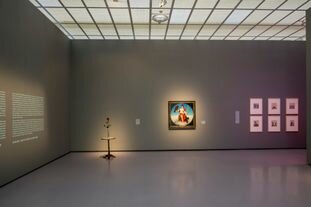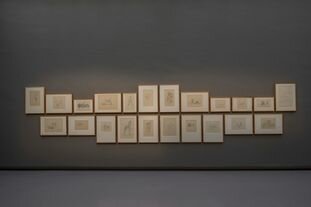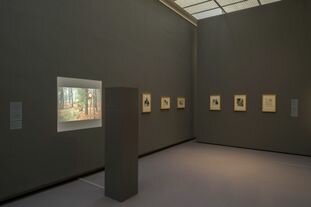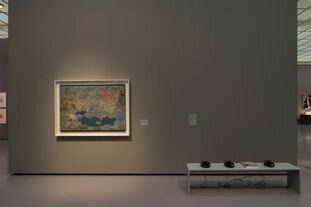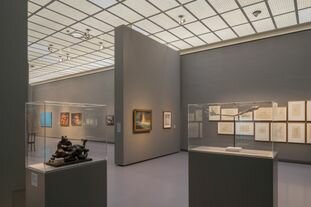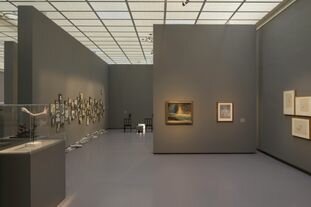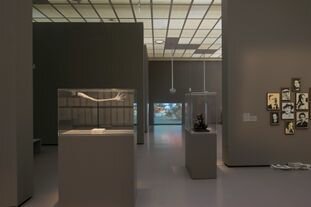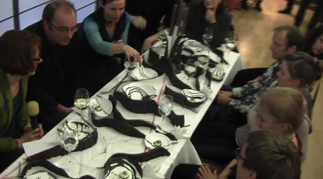exhibitions
Europe, the future of History
Kunsthaus Zürich, 12.05. - 6.09.2015
Curated by Cathérine Hug, Robert Menasse
What it's about
What image represents Europe? Is it the fall of the Berlin Wall, universal human rights, the European Football Championships and the Eurovision Song Contest? Not since Antiquity has a single image stood for Europe. Today, Europe is a multifaceted mosaic that, despite tectonic tensions beneath the surface, is no longer at risk of breaking apart. This is the thesis underlying the exhibition, which presents over 100 paintings, drawings, photographs, videos and installations by some 60 modern or contemporary artists. They encounter literary and political statements by well-known figures in an exploration of Europe as peace project.
Renationalization versus Internationalism
Curator and art historian Cathérine Hug and the Viennese writer Robert Menasse, who is acting as advisor to the exhibition, base their presentation on a political insight. At the beginning of the third millennium, the continent of Europe finds itself in a paradoxical situation. More states than ever have democratic constitutions, yet the symptoms of crisis are ever more apparent in countries such as France, the United Kingdom and Germany that were once in the socio-political avant-garde. Citizens perceive a democratic deficit and are expressing a desire for renationalization through the choices they make at the ballot box. This is the second paradox: for in a Europe that is interlinked technologically, economically and ecologically, national action alone no longer suffices to resolve problems. Europeans are bound together by more than just territory: they share a complex past and, following the horrors of the Second World War, a resolve to shape a future founded on solidarity and peace.
Art in search of a peaceful Europe
The exhibition tells of utopias and dreams – and of reality. By tracing the history of ideas, it sets out to convey how the seemingly abstract vision of a peaceful Europe is made manifest. Back in 1826 Heinrich Heine anticipated what every modern-day special interest group has realized: ‘Day by day the ridiculous prejudices of races are disappearing; all harsh peculiarities are disappearing in the universality of European civilization, there are no longer nations but parties.’ What party, then, is art? Why does a museum line up behind a political project; and does that project then become cultural?
Europe - the future of history [exhibition catalogue english)
Europe: the future of history : [this catalogue is published on the occasion of the exhibition "Europe, the future of history", Kunsthaus Zürich, Juni 12th - September 6th 2015] / Kunsthaus Zürich ; Cathérine Hug ; in cooperation with Robert Menasse. - [Zurich] : Verlag Neue Zürcher Zeitung, c2015. - 312 S. : Ill., partly with colour; 28 cm
SALON SOPHIE CHARLOTTE
future location: EUROPe
Saturday, Januar 18th, 2014
Berlin-Brandenburgischen Akademie der Wissenschaften
Markgrafenstraße 38, 10117 Berlin
Säulensaal, 2. Obergeschoss
Within the scope of the annual topic „future location: EUROPE“ of the „Berlin-Brandenburgischen Akademie der Wissenschaften“ (BBAW) six alumni of the Villa Aurora, the former residence of Lion Feuchtwanger in Pacific Palisades, Los Angeles, CA, USA, represented their artworks and visions for a Europe of tomorrow.
The Villa Aurora Forum in Berlin and the BBAW have a close cooperation for many years that goes beyond the fact that the offices of the Villa Aurora are placed in the premises of the Academy. The annual topic is offering a great opportunity for the alumni of the Villa Aurora to participate on the debate about which direction the European continent needs to go.
Europe is not only perceptible as an economic area, but also as a culture and legal area. It shouldn‘t get lost in the maelstrom of aversion, scepticism and implicitness. By means of the Salon Sophie Charlotte 2014 the Academy wants to contribute orientation to historical excursions as also to current location determinations and visions of the future.
The alumni Anna Faroqhi, Norbert Zähringer, Valeska Peschke, Antje Vowinckel and Franz Martin Ulbrich as well as their guests and partners will present their point of view on the different media and formats. The artworks include videos, sound installations, readings and performances.
Interactive Performance by Valeska Peschke with Robert Menasse and Ulrike Guérot
(link to Video)
Thirteen artists, authors and scientists are gathered around a festively decorated banquet that is shaped after the landscape of Amikejo in black and white ceramic. These thirteen people think about Europe’s future with the historic model of the stateless place Neutral-Moresnet. The group gathered around this banquet is focused on thinking further about the initiative that was creatively implemented by Valeska Peschke.

Christoph Balzar, artist, Tanja Dückers, author, Paola Ferruta, Historian, Berlin, Paris, Rome, Georg Göschl, European Democracy Lab, Ulrike Guérot, political scientist, Berlin - Europe, Michael Hohl, professor for design theory, Dessau. Victoria Kupsch, European Democracy Lab, Robert Menasse, author, Austria, Jutta Obrowski, PR DSO Berlin, Melissa de Raaf, filmmaker, Berlin, Zuzanna Skiba, visual artist with a pictorial and cartographical view, Steffen Wedepohl, literary scholar, editor, Berlin.
Starting the project in a moderate way and achieving a result in an art space as an installation with a performance we thought of an appropriate modification: the inflatable architecture embassy will be presented by absence. The installation in an art space is just giving hints to the existence of the whole idea without being built in its full size.
Kasside
The idea for this attitude is inspired by a central motiv of nomadic poetry, originated by preislamic nomads on the arabic peninsula: the image of the abandoned camp-site, that is descibed extensively by the poet. The poet arrives at a place where the lover has lived for some time with her tribe, but he/she has come too late. Instead of finding the lover and the fulfillment of his longing love, only obliterate traces are found of his desires and dreams. This yearning elegy is the classical introduction in the form of lyric poetry, the Qasida. This is the overture, the leitmotiv of the whole lyric.
In the same way we stage the idea of the european utopia. The embassy of Amikejo stands for utopian ideas, in the art space this utopian idea is remnant and has left only traces. Thiscondition represents also the condition of the european idea of freedom, justice, peace, withdrawn by national power-struggle, cynism, materialism. In order to discover these goals again it seems to be important to really miss them, simiar to the absent lover at the deserted camp-site. In the consciosness of deficit the idea rallies to a desire and then unfolds to a plan for a better future.
Copyright © All Rights Reserved Idea & Concept & Art by Valeska Peschke, Berlin 2017

